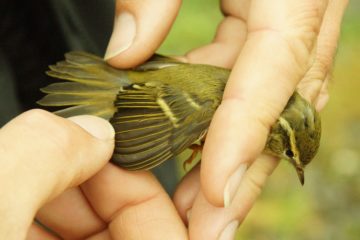With just a hint of frost on the 3/10/19 we were able to ring at Howick capturing and processing 63 new birds and 17 retraps. One of the most notable observations was the constant passage of geese overhead for most of the morning; apparently heading both to and from the coast. We captured a Chaffinch (Z299033) that had originally been ringed as a juvenile on the 6/9/14; there was also a male Nuthatch ringed as a second-year bird (coded a ‘5’) on the 27/7/18 and a juvenile Great Spotted Woodpecker just moulting out its distinctive red ‘tonsure’ (see pict.). Anyone who birdwatches at Howick will know that nuthatches and Great Spots and regulars in the arboretum. While Blackcaps seem to have mostly already travelled south on their migration, we were still catching lots of Chiffchaffs but on this morning we also ringed a beautiful Yellow Browed Warbler (see pict.). It’s now generally believed that this bird is pioneering a new migration pattern, away from its normal route from Russian down into China; and instead down through Scandinavia, Continental Europe and into Africa. We also had lots of Goldcrest and Goldfinch and late on in the morning a single adult Blackcap; making what must be its second or third annual trip south for the winter (most stop around the Mediterranean or North Africa rather than travelling right across the Sahara like many of our other warblers). Finally, an unusual Robin caught our attention – having unusually orange under-claws; not something anyone had seen before.
The 5th proved equally interesting with 80 new birds and 23 retraps; with the first bird captured being our regular winter migrant from Scandinavia a Redwing (see pict.). They are not a large bird (unlike their cousins the Fieldfare or Mistle Thrush) being rather similar to our more resident Song Thrush but they are generally longer winged and slightly heavier. We indeed quickly capture a Mistle Thrush and then a Song Thrush – all heading for the Guelder Rose berry-bearing bushes within the ringing site. Next, we captured a rather unusual looking Chaffinch; it was rather dark coloured with long wings and tail (72 mm); this is almost certainly a continental bird. Another migrating Yellow Browed Warbler led to some excitement and we had our usual catch of resident finches, tits and eventually two Treecreepers.

Ringing on the 12th was quieter with only 17 new birds and 9 retraps but the quality was good including Mistle Thrushes, Song Thrush and Bullfinch. Numbers went up again on the 19th with 50 new birds and 16 retraps including a Chaffinch originally ringed on the 15/7/15 and a Goldfinch from 14/7/16. In all 13 different species were processed but we (the ringers) all got soaked by the rain on packing-up at 12:30!
Spurred on by the presence of Waxwing at Howick on the 24th we only actually captured 12 new birds and 5 retraps. However, these included a re-trap Goldcrest, originally ringed at Howick on the 15/9/18 (see picture showing the red male crown feathers); and new Redwing, a Great Spotted Woodpecker and a late Chiffchaff. The Chiffchaff was carrying a great deal of body fat (which we scored as ‘5’) and we did speculate that may-be it was one of those birds that was coming into the country from the continent to spend the winter with us.
Finally, on the 26th we started later to be sure the rain had stopped (although it remained very overcast) and caught 30 new birds and 10 retraps. There was a Goldfinch originally ringed on the 13/8/15 and one new Goldfinch was notable in having lots of yellow feathers in its head (rather than red). There were also many Blackbirds in the arboretum indicated that they were arriving migrants looking for berries to re-build their body-weight. Howick’s resident flock of Long-Tailed Tits also paid us a visit but we only captured 3 on this occasion; there were lots of finches and tits around as well.
We stop ringing at Howick in the middle of November but do ring at some other locations during the winter when weather permits. If interested in ringing please get in touch. Phil Hanmer ‘A’ Ringer/Trainer; Natural History Society of Northumbria Ringing Group (Hancock Museum). E-mail: tytoalbas@btinternet.com